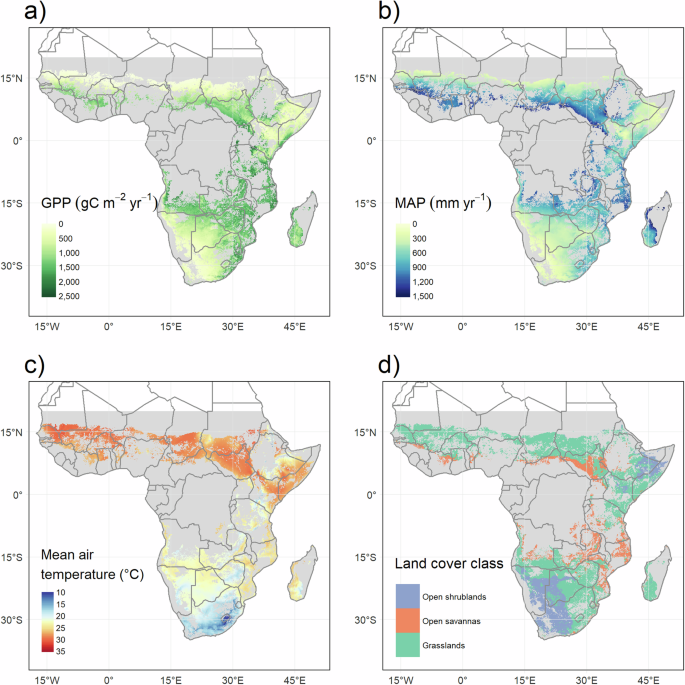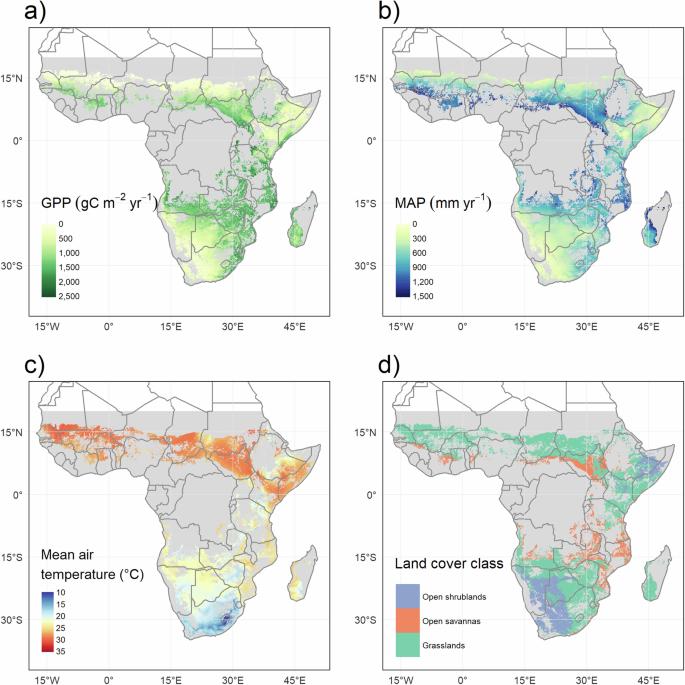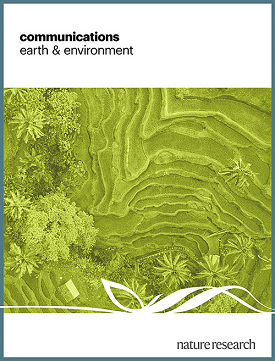Untangling the environmental drivers of gross primary productivity in African rangelands
IF 8.1
1区 地球科学
Q1 ENVIRONMENTAL SCIENCES
引用次数: 0
Abstract
Precipitation variability is forecast to increase under climate change but its impacts on vegetation productivity are complex. Here, we use generalised additive models and remote sensing-derived datasets to quantify the effect of precipitation amount, distribution, and intensity on the gross primary productivity of dry rangelands across sub-Saharan Africa from 2000 to 2019 and differentiate these effects from other variables. We find that total precipitation is the primary driver of productivity, but that more variable rainfall has a small negative effect across vegetation types and rainfall regimes. Temperature and soil nitrogen also have strong effects, especially in drier rangelands. Shrublands and grasslands are more sensitive to environmental variability than savannas. Our findings support a model in which the main constraints on productivity are maintenance of soil moisture and minimisation of plant water stress. This highlights the risks of climate warming and increasing variability for productivity in water-limited grass and shrublands but suggests savannas may have greater resilience in Africa. Total precipitation, temperature and soil nitrogen are the main drivers of gross primary productivity in dry rangelands in sub-Saharan Africa, with more variable rainfall having a small but negative impact, according to analysis of remote sensing datasets using generalised additive models.


理清非洲牧场总初级生产力的环境驱动因素
据预测,在气候变化的影响下,降水的变异性将会增加,但其对植被生产力的影响却十分复杂。在此,我们利用广义加法模型和遥感数据集,量化了 2000 年至 2019 年降水量、分布和强度对撒哈拉以南非洲干旱牧场总初级生产力的影响,并将这些影响与其他变量区分开来。我们发现,总降水量是生产力的主要驱动因素,但在不同的植被类型和降水制度下,降水量变化较大会产生较小的负面影响。温度和土壤氮也有很大影响,尤其是在较干旱的牧场。灌木林和草地比热带稀树草原对环境变化更为敏感。我们的研究结果支持这样一种模式,即生产力的主要制约因素是保持土壤湿度和最大限度地减少植物水分胁迫。这凸显了气候变暖和变异性增加对水源有限的草地和灌木地生产力的风险,但同时也表明热带稀树草原在非洲可能具有更强的恢复能力。利用广义加法模型对遥感数据集进行的分析表明,总降水量、温度和土壤氮是撒哈拉以南非洲干旱牧场初级生产力总值的主要驱动因素,而降雨量的变化虽小,但却有负面影响。
本文章由计算机程序翻译,如有差异,请以英文原文为准。
求助全文
约1分钟内获得全文
求助全文
来源期刊

Communications Earth & Environment
Earth and Planetary Sciences-General Earth and Planetary Sciences
CiteScore
8.60
自引率
2.50%
发文量
269
审稿时长
26 weeks
期刊介绍:
Communications Earth & Environment is an open access journal from Nature Portfolio publishing high-quality research, reviews and commentary in all areas of the Earth, environmental and planetary sciences. Research papers published by the journal represent significant advances that bring new insight to a specialized area in Earth science, planetary science or environmental science.
Communications Earth & Environment has a 2-year impact factor of 7.9 (2022 Journal Citation Reports®). Articles published in the journal in 2022 were downloaded 1,412,858 times. Median time from submission to the first editorial decision is 8 days.
文献相关原料
| 公司名称 | 产品信息 | 采购帮参考价格 |
|---|
 求助内容:
求助内容: 应助结果提醒方式:
应助结果提醒方式:


